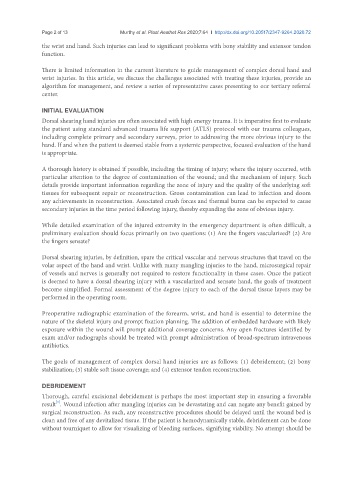Page 752 - Read Online
P. 752
Page 2 of 13 Murthy et al. Plast Aesthet Res 2020;7:64 I http://dx.doi.org/10.20517/2347-9264.2020.72
the wrist and hand. Such injuries can lead to significant problems with bony stability and extensor tendon
function.
There is limited information in the current literature to guide management of complex dorsal hand and
wrist injuries. In this article, we discuss the challenges associated with treating these injuries, provide an
algorithm for management, and review a series of representative cases presenting to our tertiary referral
center.
INITIAL EVALUATION
Dorsal shearing hand injuries are often associated with high energy trauma. It is imperative first to evaluate
the patient using standard advanced trauma life support (ATLS) protocol with our trauma colleagues,
including complete primary and secondary surveys, prior to addressing the more obvious injury to the
hand. If and when the patient is deemed stable from a systemic perspective, focused evaluation of the hand
is appropriate.
A thorough history is obtained if possible, including the timing of injury; where the injury occurred, with
particular attention to the degree of contamination of the wound; and the mechanism of injury. Such
details provide important information regarding the zone of injury and the quality of the underlying soft
tissues for subsequent repair or reconstruction. Gross contamination can lead to infection and doom
any achievements in reconstruction. Associated crush forces and thermal burns can be expected to cause
secondary injuries in the time period following injury, thereby expanding the zone of obvious injury.
While detailed examination of the injured extremity in the emergency department is often difficult, a
preliminary evaluation should focus primarily on two questions: (1) Are the fingers vascularized? (2) Are
the fingers sensate?
Dorsal shearing injuries, by definition, spare the critical vascular and nervous structures that travel on the
volar aspect of the hand and wrist. Unlike with many mangling injuries to the hand, microsurgical repair
of vessels and nerves is generally not required to restore functionality in these cases. Once the patient
is deemed to have a dorsal shearing injury with a vascularized and sensate hand, the goals of treatment
become simplified. Formal assessment of the degree injury to each of the dorsal tissue layers may be
performed in the operating room.
Preoperative radiographic examination of the forearm, wrist, and hand is essential to determine the
nature of the skeletal injury and prompt fixation planning. The addition of embedded hardware with likely
exposure within the wound will prompt additional coverage concerns. Any open fractures identified by
exam and/or radiographs should be treated with prompt administration of broad-spectrum intravenous
antibiotics.
The goals of management of complex dorsal hand injuries are as follows: (1) debridement; (2) bony
stabilization; (3) stable soft tissue coverage; and (4) extensor tendon reconstruction.
DEBRIDEMENT
Thorough, careful excisional debridement is perhaps the most important step in ensuring a favorable
[1]
result . Wound infection after mangling injuries can be devastating and can negate any benefit gained by
surgical reconstruction. As such, any reconstructive procedures should be delayed until the wound bed is
clean and free of any devitalized tissue. If the patient is hemodynamically stable, debridement can be done
without tourniquet to allow for visualizing of bleeding surfaces, signifying viability. No attempt should be

